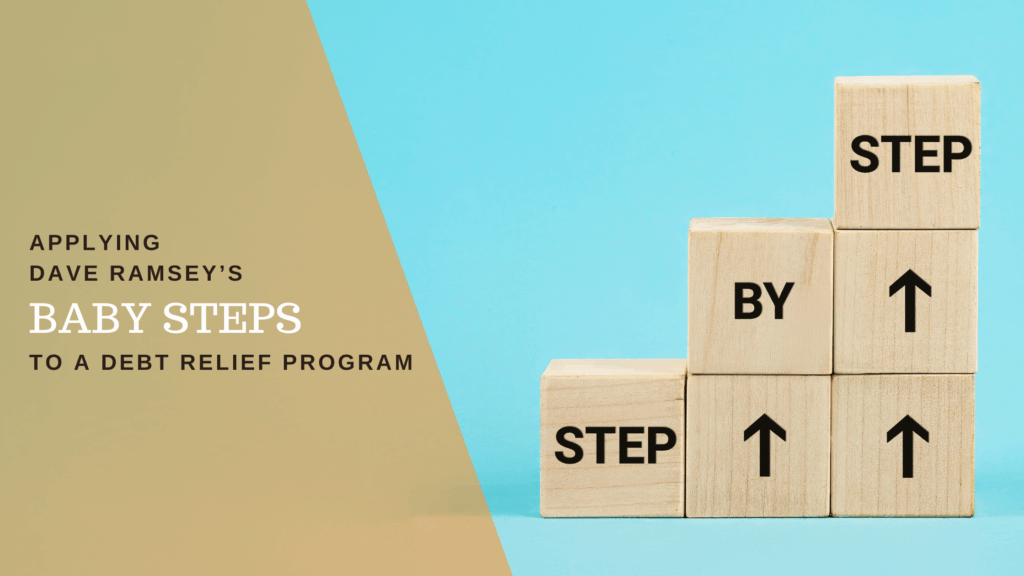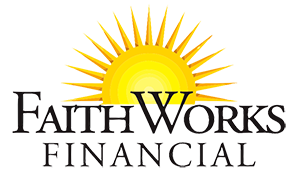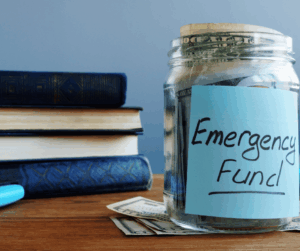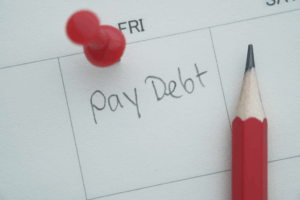Applying Dave Ramsey’s Baby Steps to A Debt Relief Program

Table of contents
- Introduction
- An Overview of Dave Ramsey’s 7 Baby Steps
- Baby Step 1- Save $1,000: Emergency First, Even During a Debt Relief Program
- Baby Step 2- Pay Off All Debt Except the House Using the Debt Snowball Method
- Baby Step 3- Establish a Fully Funded Emergency Fund
- Baby Step 4- Retirement Savings: Don’t Neglect the Future
- Baby Step 5- Children’s College Fund: A Matter of Timing
- Baby Step 6- Pay Off Your Home Early: A Future Target
- Baby Step 7- Build Wealth and Give: A Greater Purpose
- Why the Baby Steps Still Apply After Starting a Program
FaithWorks Financial is not affiliated with or endorsed by Ramsey Solutions. “Dave Ramsey” and “Baby Steps” are registered trademarks of Ramsey Solutions. Learn more about Dave Ramsey’s 7 Baby Steps at RamseySolutions.com
Introduction
Many Christians are familiar with Dave Ramsey’s Baby Steps, a core foundation of Financial Peace University, which churches and community groups facilitate nationwide. Dave Ramsey motivates people out of debt and into lasting wealth like few others. The Baby Steps represent more than just a roadmap to become debt-free. They’re a framework for financial peace rooted in discipline, stewardship, and biblical wisdom.
But what happens when your current situation requires help beyond a self-directed strategy? While Ramsey’s organization has long taken a firm stance against using outside support, many debt relief programs can help you overcome debt and alleviate financial stress.
Suppose you are using a debt consolidation loan, Debt Management Plan (DMP), or debt settlement service. Can Dave Ramsey’s Baby Steps still apply to your journey?
Absolutely—and faithfully.
If you have an honest pathway to zero debt and financial security, there’s nothing wrong with taking a smart strategy. And there’s certainly nothing wrong with getting outside help when you’re in a financial emergency. You can still apply Ramsey’s 7 Baby Steps to help you become debt-free even faster and for good.
We’re going guide you through applying the 7 Baby Steps to a debt relief program—and show how a faith-driven approach can enhance both the practicality and the purpose behind it.
An Overview of Dave Ramsey’s 7 Baby Steps
Here’s a snapshot of Dave Ramsey’s 7 Baby Steps, designed to take individuals from debt to wealth:
- Save $1,000 for a starter emergency fund
- Pay off all debt except your house using the debt snowball method
- Save 6 months of monthly expenses for a full emergency fund
- Invest 15% of household income into retirement savings
- Save for your children’s college fund
- Pay off your mortgage early
- Build wealth and give generously
Whether you’re working through Christian debt management or consolidating multiple loans, these steps still apply—with some thoughtful modifications.
Baby Step 1- Save $1,000: Emergency First, Even During a Debt Relief Program
Most financial experts agree that it’s wise to establish a safety net, even when you’re in debt.
Baby Step One begins with a starter emergency fund of $1,000. A bit of extra money in savings can mean the difference between a solvable hurdle and a financial disaster. If you’re in a debt relief plan, that might sound impossible—but $1,000 is an achievable goal, and it should be your priority.
An emergency fund moves you from debt-reliance toward self and God-reliance. A $1,000 emergency fund not only provides a financial cushion but also a greater treasure: peace of mind. It acts as a psychological safety net, reducing stress and helping you stay grounded when financial anxiety creeps in.
Getting To $1,000—Reduce Expenses and Increase Income
To save your $1,000 emergency savings, you can reduce monthly expenses or increase your income. Most of us have money going out on unnecessary or forgotten expenses. Look for quick wins to reduce expenses or minimize payments on regular bills. On the flipside, even a small side income can make a big difference as you work to become debt-free.
Quick Ways to Reduce Expenses
- Request reduced interest rates on credit cards and personal loans
- Consolidate high-interest credit card debt to lower monthly payments and interest expense
- Pause subscriptions (streaming, gym, apps) for 30–60 days
- Meal plan to avoid food waste and reduce takeout spending
- Shop with a list to avoid impulse purchases
- Call service providers to negotiate lower rates (internet, phone, insurance)
- Use cash envelopes for categories like groceries or gas
- Limit non-essential driving to save on fuel
Simple Ways to Boost Income
- Sell unused items on Facebook Marketplace, eBay, or OfferUp
- Pick up a short-term side job (rideshare, tutoring, pet sitting, or freelancing on UpWork)
- Offer services in your community—cleaning, babysitting, yard work
- Look for seasonal or weekend work at local businesses or churches
- Monetize a hobby (art, music lessons, handmade crafts)
- Ask for overtime or additional shifts if your job allows
- Rent a room on Airbnb or an unused car on Turo
“All hard work brings a profit, but mere talk leads only to poverty.”
Building a $1,000 emergency fund may feel like a mountain right now—but with focus, prayer, and persistence, it’s a hill you can climb. Start small. Stay consistent—transition from debt reliance to self and God-reliance.
Baby Step 2- Pay Off All Debt Except the House Using the Debt Snowball Method
This step is the heart of Ramsey’s strategy—and it remains fully usable, even if you’re enrolled in a Debt Management Plan (DMP), enrolled in a debt settlement program or a DIY debt settlement approach, or have taken a debt consolidation loan.
One of the key reasons the debt snowball method is so effective isn’t just the math—it’s the behavioral psychology behind it. Tackling smaller debts first provides quick wins, helping to build motivation and confidence as you progress.
People struggling with debt often feel frustrated and stuck. And without a clear and realistic plan for repayment, that makes sense.
Creating a zero-based budget assigns a specific purpose to every dollar, facilitating effective money management. Those who successfully regain control over their debt tend to experience improved mental well-being and reduced stress levels.
Achieving lasting debt freedom depends on behavior, not just math. Building habits like budgeting, delayed gratification, and regular saving lays the groundwork for lifelong financial health. Smart approaches, like using the debt snowball method, create momentum for your money.
You begin by listing all your debts in order from smallest balance to largest—regardless of interest rate. Then, you pay minimum payments on all debts except the smallest, allocating every available extra dollar to that smallest account.
Once you pay off each account, you roll that freed-up payment into the next debt on the list. Over time, the amount you’re applying to each successive debt grows like a snowball rolling downhill.
Taking Stock of Your Debt Situation
Before you can implement the debt snowball effectively, you need to take a complete inventory of your outstanding debts. The exercise isn’t just about writing down balances—it’s about organizing your debt into a clear, actionable format that allows you to track progress over time.
The best way to do this is by creating a simple spreadsheet. Whether you use Excel, Google Sheets, or a notebook, your list should include the following columns:
- Debt Name
- Total Balance
- Minimum Monthly Payment
- Snowball Payment (for snowball targeting)
- Estimated Payments Remaining
- Notes (e.g., part of a DMP, account details, creditor name, etc.)
Then, begin to list on the spreadsheet any non-mortgage debt you have:
- Credit cards
- Student loans
- Car loans
- Personal loans
- Medical bills
- Collection accounts
- Debt consolidation loans
- Debt management plan (DMP)
- Debt settlement program
Organizing Your Debts for the Snowball
Once you’ve listed your debts in a spreadsheet, arrange them from smallest to largest balance, regardless of the interest rate. This is a key principle of the debt snowball method: it’s not about optimizing math, it’s about psychological motivation.
You’re aiming for quick wins, because paying off even one debt—no matter how small—creates confidence and momentum.
Where Debt Relief Programs Belong in Your Debt Snowball
Even though debt relief programs often involve multiple underlying debts, you’ll be tackling them as a single unified payment. For this reason, when listing your debts, treat each loan, DMP, or settlement program as a single line item—just like you would an individual credit card or personal loan.
Here’s what a debt snowball list might look like with a debt relief program in the mix:
Debt | Balance | Min. Payment | Snowball Payment | Payments Remaining | Notes |
|---|---|---|---|---|---|
| Retail Credit Card #1 | $422 | $30 | $250 | 2 | Snowball! |
| Student loan | $4,401 | $94 | $94 | 46 | |
Consolidation Loan | $6,280 | $185 | $185 | 34 | |
DMP | $24,010 | $530 | $530 | 52 | 4 credit cards included |
Settlement Program | $24,010 | $457 | $457 | 42 | 1 credit card settled, 3 in negotiation |
| Car loan | $29,550 | $615 | $615 | 48 |
If you were in a DMP or settlement program, you might use the “notes” column to list how many accounts are enrolled or, as time goes on, how many have been paid or settled.
Keeping up with a debt snowball spreadsheet gives you a constant bird’s-eye view of your repayment progress. You’ll place all of the debts you owe on this spreadsheet, As you work through your snowball, you’ll see the number of remaining payments shrink—and your financial freedom grow.
“The plans of the diligent lead to profit as surely as haste leads to poverty.”
Accelerate The Repayment of Your Smallest Debt
Most debt management and debt settlement programs allow (and often encourage) you to add extra funds beyond your minimum monthly payments. Once one of these programs becomes your smallest remaining debt, it becomes your next snowball target.
That means it’s time to go all in—apply every extra dollar you can to speed up repayment. The faster you eliminate that debt, the sooner you can roll its payment into the next, gaining more momentum with each win.
Baby Step 3- Establish a Fully Funded Emergency Fund
Do not begin Baby Step Three until you’ve completed your debt payoff. Do all you can to accelerate the debt repayment. That includes your debt relief program, credit cards, student loans, car loans, and any other non-mortgage debt.
At that time, step three becomes your next big move: saving 3–6 months of expenses in a fully funded emergency fund.
This larger emergency fund is your safety net against job loss, unexpected medical bills, or car repairs.
Debt Advisor Tip: Don’t let a medical emergency deplete your emergency fund without first exploring charity care options. Most non-profit hospitals offer charity care assistance, which can reduce or eliminate medical debt based on household size and income.
Baby Step 4- Retirement Savings: Don’t Neglect the Future
Making it to Baby Step 4 is a huge win! From here on, it’s not about cutting the expense of debt, but stepping toward smart investment.
Investing 15% of household income for retirement may not feel realistic if you’re still knee-deep in debt repayment. That’s okay. However, as soon as you are able—especially once your program is complete—start contributing to retirement savings consistently.
If you’re still in your 20s or 30s, don’t underestimate the power of small contributions. Thanks to compound growth, investing even $50 a month now can become a sizable nest egg by the time you retire. Waiting to invest until you’re debt-free might mean missing out on years of exponential growth.
We encourage learning about investment strategies and speaking with a retirement planner or Christian financial planner who can help create a retirement strategy for your specific situation.
Baby Step 5- Children’s College Fund: A Matter of Timing
Baby Step 5 suggests saving for your children’s college fund. While this is noble, don’t rush it if your financial house isn’t in order. The system is meant to be worked in order.
Your kids can pursue grants, scholarships, and work-study opportunities, but there is no scholarship to support your household income in retirement. Focus first on becoming debt-free and stable, then work toward your college savings goals.
When you do, consider establishing a 529 plan or education savings account as part of your long-term financial planning. Rather than saving for their education, teach your children the value of saving, even as you plan for their own education. Helping your kids understand how a 529 plan works and giving them the freedom to fund it creates ownership and motivation, fostering faith in your family finances.
Baby Step 6- Pay Off Your Home Early: A Future Target
Paying off your home early may seem like a fantasy, but it provides a solid foundation for your future financial security.
As your financial strength improves, you can begin to take steps toward this goal:
Make extra principal payments whenever possible, even if it’s just a small amount each month. Over time, those extra dollars chip away at the balance, shorten the amortization schedule, and reduce interest paid overall.
- Refinance into a shorter term (e.g. 15 years) if the rates and closing costs make sense. A shorter term may have a slightly higher monthly payment but can significantly reduce interest burden over time.
- Reallocate windfalls (bonuses, tax refunds, gifts) toward your mortgage principal instead of new liabilities.
- Stay flexible and review regularly—as your debt profile shifts (for example, after completing your debt snowball), you might shift additional resources from those accounts to your home.
But even as you push toward early payoff, remember: there’s no need to rush forward if it jeopardizes your current obligations.
Baby Step 7- Build Wealth and Give: A Greater Purpose
Baby Step Seven is all about giving.
Dave Ramsey’s final step—build wealth and give generously—isn’t just about personal comfort or early retirement. It’s about living with eternal perspective. Wealth, in the hands of a faithful steward, is a tool for kingdom impact. Good stewardship should be the first and last lesson in any financial journey.
There are many paths to building wealth, and it doesn’t require a six-figure salary to begin. Even if you’re starting from paycheck to paycheck, you can create a life of financial security—and more importantly, a life of generosity.
Generosity is the fruit of faith-based financial stewardship, not the reward of financial perfection. In fact, as we highlight in our article, Tithing While in Debt: A Faithful Approach to Financial Stewardship, giving isn’t something to delay until you’re debt-free. Instead, it’s a heart posture. That article displays how even in seasons of financial strain, believers can take intentional, prayerful steps toward generosity—starting small, building consistency, and trusting God to multiply the impact.
Being a good steward and serving His Kingdom is the only goal.
“You will be enriched in every way so that you can be generous on every occasion, and through us your generosity will result in thanksgiving to God.”
Why the Baby Steps Still Apply After Starting a Program
Sometimes we need help, and it’s not a Christian failure to do so.
When you see a confident, God honoring path to save money while repaying your debt, don’t hesitate! There is no reason to live in shame. Christian finance offers us grace and freedom.
That said, if you do enter a debt relief program, it’s important to know you’re not quite “done.”
Yes, a Christian debt relief program can help you navigate a financial emergency, and it may feel like the pressure is finally off, but it’s essential to continue moving in the right direction. Dave Ramsey’s Baby Steps offer a proven path.
Ready to take the next step toward God-honoring financial freedom?
Whether you’re working the Baby Steps on your own or through a Christian debt relief service, you don’t have to do it alone. Take the first step toward clarity with a free, no-obligation debt counseling session from FaithWorks Financial.
We’ll help you understand your options, answer your questions, and prayerfully explore the best path forward—at your pace, without pressure.
“Plans fail for lack of counsel, but with many advisers they succeed.”
Frequently Asked Questions
Yes. Treat your DMP as one individual debt. List the balance as the total amount owed. Update the balance owed each time you make a monthly payment.
Yes. Treat your newly consolidated loan as one individual debt, with the balance being the total amount owed. Update the balance owed each time you make a monthly payment.
Yes. Treat your DMP as one individual debt, with the balance being the total amount owed. Update the balance owed each time a debt has been settled.





